External links
- Archived 20 December 2016 at the Wayback Machine
| | This Indian cuisine–related article is a stub. You can help Wikipedia by expanding it. |
| Course | Seafood curry |
|---|---|
| Place of origin | Odisha |
| Region or state | Odisha, India |
| Main ingredients | Fish, dahi (yogurt), spices |
Dahi machha is a traditional Odia delicacy made of fish in a spicy yogurt based sauce. It is eaten usually served with rice as an accompaniment. Dahi Machha Jhola is liberally seasoned with turmeric, onions, garlic, mustard and garam masala. The use of turmeric imparts a yellow colour to the sauce base. Before being served, chopped fresh cilantro may be sprinkled on top for added flavour as well as enhanced appearance.
The kinds of fish that typically used in Oriya households are ilish (called ilisi), rohu (called rohi), and catla (called bhakura). Apart from these, there are some very famous small sized fish that are normally favoured over others.
Fish, dahi, potatoes, mustard, turmeric, garlic, chilli peppers, other seasonings.
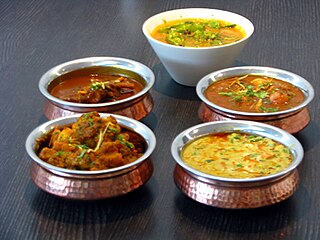
Curry is a dish with a sauce seasoned with spices, mainly associated with South Asian cuisine. In southern India, leaves from the curry tree may be included.
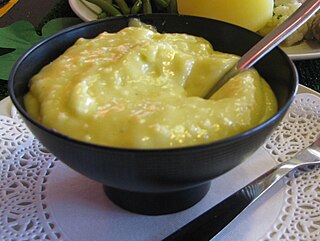
Aioli, allioli or aïoli is a cold sauce consisting of an emulsion of garlic and olive oil; it is found in the cuisines of the northwest Mediterranean.

Green sauce or greensauce is a family of cold, uncooked sauces based on chopped herbs, including the Spanish and Italian salsa verde, the French sauce verte, the German grüne Soße or Frankfurter grie Soß, the British mint sauce and greensauce, and the Argentinian chimichurri.

Rémoulade is a cold sauce. Although similar to tartar sauce, it is often more yellowish, sometimes flavored with curry, and often contains chopped pickles or piccalilli. It can also contain horseradish, paprika, anchovies, capers and a host of other items.
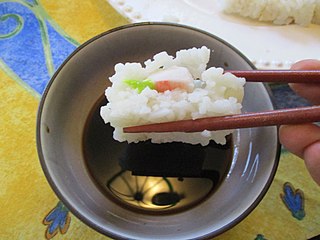
A dip or dip sauce is a common condiment for many types of food. Dips are used to add flavor or texture to a food, such as pita bread, dumplings, crackers, chopped raw vegetables, fruits, seafood, cubed pieces of meat and cheese, potato chips, tortilla chips, falafel, and sometimes even whole sandwiches in the case of jus. Unlike other sauces, instead of applying the sauce to the food, the food is typically placed or dipped into the sauce.

The generic term for condiments in the Filipino cuisine is sawsawan. Unlike sauces in other Southeast Asian regions, most sawsawan are not prepared beforehand, but are assembled on the table according to the preferences of the diner.

Odia cuisine is the cuisine of the Indian state of Odisha. Compared to other regional Indian cuisines, Odia cuisine uses less oil and is less spicy, while nonetheless remaining flavourful. Rice is the staple food of this region. Mustard oil is used in some dishes as the cooking medium, but ghee is preferred in temples. Odia foods traditionally served either on brass, bronze metal plates, banana leaf or disposable plates made of sal leaves.
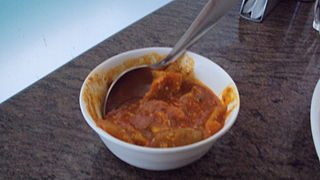
South Asian pickle is a pickled food made from a variety of vegetables and fruits preserved in brine, vinegar, edible oils, and various South Asian spices. The pickles are popular across South Asia, with many regional variants, natively known as lonache, avalehikā, uppinakaayi, pachadi or noncha, achaar, athāṇu or athāṇo or athāna, khaṭāī or khaṭāin, sandhan or sendhan or sāṇdhāṇo, kasundi, or urugaai.

Poha, also known as pohe, pauwa, sira, chira, chivda, avil or avalakki, among many other names, is flattened rice originating from the Indian subcontinent. Rice is parboiled before flattening so that it can be consumed with very little to no cooking. These flakes of rice swell when added to liquid, whether hot or cold, as they absorb water, milk or any other liquids. The thickness of the flakes varies from almost translucently thin to nearly four times thinner than a normal rice grain.

Baigan bharta or Baigan Chokha is an Indian dish prepared by mincing grilled eggplant (baigan) and mixing it with tomato, onion, herbs and spices. Grilling the eggplant over charcoal or direct fire infuses the dish with a smoky flavour. Mashed eggplant is then mixed with cooked chopped tomato, browned onion, ginger, garlic, cumin, fresh cilantro, chili pepper, and mustard oil or a neutral vegetable oil. Traditionally, the dish is often eaten with flatbread and is also served with rice or raita, a yogurt salad. In Bihar and Uttar Pradesh, it is served hot with litti or baati.

Machher Jhol, Machha Jhola, Machhak Jhor, or Machhari ke Jhor is a traditional spicy fish curry in Nepalese cuisine, Indian Cuisine and Bangladeshi Cuisine in the eastern part of the Indian subcontinent. It is in the form of a very spicy stew or gravy that is served with rice. Machher Jhol is liberally seasoned with turmeric, garlic, onions, and grated ginger and Indian spices. Potatoes are added to the curry as a thickening agent. Tomatoes are also added to impart the dish with a reddish color which is preferred by the people of Bengal.
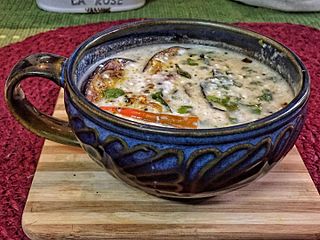
Dahi baigana is an Odia dish prepared from dahi (yogurt) and eggplant especially during festivals. This dish can be prepared without using onion and garlic when they are not allowed in some auspicious festivals.

Chingudi jhola or chungudi jhola is a spicy gravy based prawn curry with different flavours of spices. It is mostly eaten by people of the coastal regions and the areas of River basins of Odisha, India.

Nam phrik is a type of Thai spicy chili sauce typical of Thai cuisine. Usual ingredients for nam phrik type sauces are fresh or dry chilies, garlic, shallots, lime juice and often some kind of fish or shrimp paste. In the traditional way of preparing these sauces, the ingredients are pounded together using a mortar and pestle, with either salt or fish sauce added to taste.

Bumbu is the Indonesian word for a blend of spices and for pastes and it commonly appears in the names of spice mixtures, sauces and seasoning pastes. The official Indonesian language dictionary describes bumbu as "various types of herbs and plants that have a pleasant aroma and flavour — such as ginger, turmeric, galangal, nutmeg and pepper — used to enhance the flavour of the food."

Kaeng hang le is a rich Northern Thai pork curry. Kaeng hang le is very popular in Northern Thailand, well-known as a specialty of the region. The curry differs from traditional northern Thai curries in several respects: it is typically eaten with long-grained rice, not sticky rice, and uses dried spices, which are commonly used in Burmese, but not northern Thai curries. The dish is commonly served as a festive dish in northern Thailand.

Kasundi is the Asian or Bengali variety of mustard sauce or relish. It has the pungent paste of fermented mustard seeds, spices and sometimes dried mangoes, dried Indian plum and olives. Kasundi is popular as a dipping sauce in Bengali cuisine.

Ginataang isda is a Filipino fish stew made from fish and leafy vegetables in coconut milk with garlic, ginger, onion, patis or bagoong alamang, and salt and pepper. It is a type of ginataan. A common version of the dish, known as ginataang paksiw na isda or paksiw na isda sa gata, is additionally soured with vinegar. Ginataang isda is a type of ginataan.